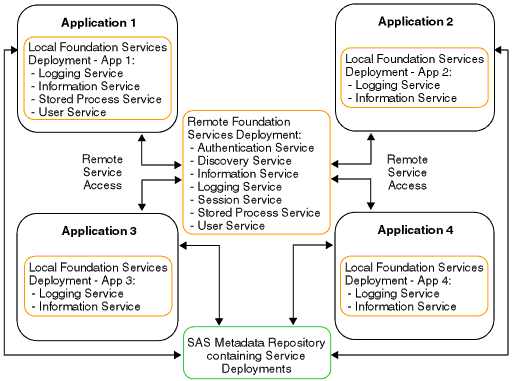Understanding How Applications Deploy Foundation Services
Applications can access service
deployments from a SAS Metadata Repository or an XML file (that contains
exported metadata). Applications deploy services as follows:
-
For a local service deployment, the application uses a service loader utility to instantiate and initialize the SAS Foundation Services for a local service deployment and to register the deployed services with a local Discovery Service. The application then has exclusive access to these locally deployed services. For a stand-alone deployment, you do not need to configure a Discovery Service.
-
For a remote service deployment that is shared between applications, one of the applications must deploy the remote service deployment. The application uses a service loader utility to instantiate and initialize the foundation services for a remote service deployment and to register the deployed services with a local Discovery Service. The application then has local access to the services. To enable the services for remote access, the remote service deployment specifies a remote Discovery Service that registers with the service registry. The remote service deployment also contains a distributable configuration for any service that remote clients access. These remote services are registered with a remote Discovery Service. Other applications can then use the remote Discovery Service to access the remote services.
Note: A foundation service-enabled
application can be either a standard client application or a Web client
application that runs in a servlet container.
Your application must install the
appropriate JAR files (for example, sas.svc.core.jar) in a location
that is accessible only to its own classloader. This installation
restriction is due to the inheritance hierarchy of classloaders. This
inheritance hierarchy enables multiple applications to access classes
that are available to higher level class loaders. Therefore, each
foundation service-enabled application should not install the required
JAR files in a location that is accessible to a class loader that
might be shared among multiple applications. For details about coding
client applications for service deployment, see the SAS Foundation
Services class documentation for
com.sas.services.deployment and com.sas.services.discovery at http://support.sas.com/rnd/javadoc/93 and the SAS
Integration Technologies: Java Client Developer's Guide.
In the figure, Applications
1 through 4 all access their local and remote service deployment configurations
from a SAS Metadata Repository.
If Application 1 deploys
the remote service deployment, the services are registered with a
local Discovery Service and a remote Discovery Service. Applications
2, 3, and 4 can then use the remote Discovery Service to locate and
access the deployed remote services. All of the applications share
the same remote service deployment. In addition, each application
has exclusive access to its own local service deployment. For information
about how applications locate and access services, see Understanding How Applications Locate Foundation Services .
The different components
in the preceding figure might exist on the same Web server or on different
Web servers. You can install your applications and deploy your services
on separate machines as required by the needs of your implementation.
For information about distributing service deployments, see Redistributing Service Deployments.
